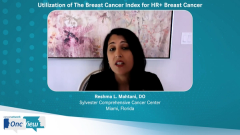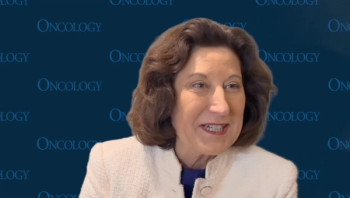
Identifying Patients for Extended Adjuvant Therapy With the Breast Cancer Index in HR+ Breast Cancer
Role of the Breast Cancer Index genomic index in therapeutic decision-making in the extended adjuvant setting in HR+ breast cancer.
Episodes in this series

Kristie Kahl: How does the Breast Cancer Index [BCI] differ from the other assays in terms of the information it provides regarding extended adjuvant therapy? What are the data that support its use?
Vijayakrishna Gadi, MD, PhD: The other ones with high-quality evidence are focused a lot more on prognostication, but also looking at the benefits of chemotherapy in certain groups vs not. The 1 that has the greatest precision as well as the greatest predictive benefit in the extended adjuvant setting is the BCI test. It is composed of 2 separate scores: 1 is the prognostic score, and 1 is the predictive score. In particular, the predictive score is focused on this ratio of just 2 genes, this H:I [HOXB13:IL17BR] index.
When we focus on that test, it really helps us figure out who might benefit from being on antiestrogen therapy for longer than the conventional 5 years. There are only 3 studies that support its use and are validating its use in this context. They are large studies that have focused on this aspect of extended endocrine therapy, and they were able to take a subset of the tissue blocks from those studies, analyze them with this score, and then basically determine which group of those patients, based on the gene expression of that test, would benefit from extended therapy.
One of the studies is the MA.17 trial. That trial initially looked at patients who would have received tamoxifen for 5 years and randomized them to an aromatase inhibitor vs placebo. In the parent study, there was a minuscule benefit when they showed extended therapy having occurred. Subsequently, it was not widely accepted as useful because the benefits were so low, yet there were all these risks from being on therapy for longer. As a result, the team at this company focused on this test, specifically in a subset of roughly 250 patients. They were able to show that when they categorized patients as high, there was a 65% reduction in the risk of disease in those patients when they extended therapy, and that when they categorized the patients as low risk, there was no benefit.
The next trial they were able to publish on was based on the ADAM trial, which looked at tamoxifen—after an initial 5 years of tamoxifen, adding on 5 more years. In that study, they also showed—based on the high-risk score vs low-risk score—a 65% reduction in recurrences in the high risk and no benefit in the low risk. In both trials where they took a subset of the patients, they were able to show this consistent benefit.
More recently, there was a study called IDEAL [Investigation on the Duration of Extended Adjuvant Letrozole], from which they published a paper showing 900 patients from that trial. They looked at patients who either had tamoxifen, an aromatase inhibitor, or a combination of the 2 for 5 years, and randomized those patients to 2½ years of an aromatase inhibitor vs 5 years. That’s different from how we practice; we usually stop at 5 years. In this group, they showed a roughly 60% reduction in recurrence when women extended for 5 years vs 2½ in that trial in the high-risk group, vs no benefit in the low-risk group.
What I hope is going to come out 1 day is this question that’s more imperative regarding patients on 5 years of aromatase inhibitors who are then being considered for an additional 5 years. We do have a trial that looks at this, an NSABP [National Surgical Adjuvant Breast and Bowel Project] study. Overall, for the entire population, it does show a modest improvement for extending for that 5 years over the first 5 years. But the devil is in the details: Who is going to benefit and who is not? My understanding is that there might be some analysis of the blocks from that trial to see if they can determine, using this test: You’ve done 5 years of an AI [aromatase inhibitor]. Is adding 5 more years of an aromatase inhibitor going to benefit you? I know that was a very long answer, but that’s really the heart of what this test can tell us.
Kristie Kahl: How do you think the use of the Breast Cancer Index will affect clinical practice and patient outcomes?
Vijayakrishna Gadi, MD, PhD: First, it would be great as we practice medicine moving forward, if we collect this data and have an understanding of whether this test is really doing what we need it to do, which is what some of my research focus is on. But the hope is that if we can more carefully select patients who are going to benefit from being on the therapy for longer, then we get more bang for our buck, and those patients will actually benefit. We need to prove that in a prospective manner. All signs point to yes, this will be the outcome based on the retrospective studies we have, and the level 2a evidence we have, but ultimately, we need to see that this happens.
That is 1 benefit where we can help patients determine what they need to do. Then societally, if we can lower the burden of women recurring later, then there are lots of benefits to that, because that spares them toxic and harmful therapies, chemotherapies, CDK4/6 inhibitors, and all these other therapies that we use in those women who’ve recurred even after 5 years. To be able to save those women from having to deal with that would be a true achievement.
Transcript edited for clarity.
Newsletter
Stay up to date on recent advances in the multidisciplinary approach to cancer.























































































